In November 2012, Junko Tashiro traveled to Ghana under an Acumen Global Fellowship to launch Copa Connect, a social venture aimed at integrating smallholding rice farmers into the value chain. In her fourth and final installment, Tashiro reports on the heartening outcomes of the pilot program she organized and oversaw.
* * *
It was late March, almost five months since my arrival the previous November. Since the start of the year, I had been working about 15 hours a day without respite, weekends and holidays included. Even so, the challenges before me remained so daunting that I barely had time to come up for breath. We progressed in fits and starts, three steps forward, two steps back. On some days we seemed farther from our goals than ever.
In West Africa, progress is never easy. There were days when I could have ground my teeth in frustration. Sometimes I swam desperately against the current. Other times I just let myself float downstream, accepting the fact that many forces here were simply beyond my control.
The Darkest Hour
Take power outages. Ghana is plagued by chronic energy shortages, and every part of the country experiences blackouts lasting several hours a day. Above and beyond that, Sogakope had its own 12-hour planned outages every other day. The timing varied, but for me the worst blackouts were those that lasted from 6 pm until 6 am. This completely disrupted my routine of visiting farms or meeting with program partners during the daytime and then settling down in the evening to work on my laptop. In Sogakope, the sun goes down soon after 6 pm, and with the power off, the whole village turned pitch black and still, without a breeze stirring.
Neither the office nor my residence had an electric generator, but I kept working as long as my laptop battery allowed. Flying ants made a nuisance of themselves, landing on the glowing laptop screen and on my perspiring face. A creepy rustling filled the darkness around me as the family of geckoes that lived in the rafters made themselves at home scampering about my room. (This I knew from having come close to trampling one on several occasions.) Outside, the frogs struck up a loud chorus, periodically joined by the howls of wild dogs.
But all this lasted for only an hour or so, until my laptop battery died. After that, there was nothing to do but curl up on my damp, moldy-smelling bed and try to sleep. I shut my eyes, determined to make the most of this opportunity to rest and build up my strength. But I was not in a position to just forget my cares and drop off at eight in the evening. And here I was with so much to do that a full 24-hour day seemed insufficient.
Those Ghanaian nights were stifling. If I lay perfectly still in the heat, I would eventually drift off into semi-consciousness—but only to be awakened by my repetitive dreams. Sometimes I was frantically trying to complete a financial model on Excel; at other times I might dream about the dinner I had to skip that night. (Ghana suffers from chronic shortages of gas and water as well as electric power, and the housekeeper in our compound would frequently use the gas shortage as an excuse not to make dinner. Meanwhile, I was often too engrossed in work to go out and buy food for myself.)
However, there was one recurring dream in particular that invariably jarred me awake. In this dream, I’m walking along the side of a beautiful greenish-gold rice paddy, when a farmer comes toward me, followed by another and another. They converge on me, clamoring for answers. “When is my paddy going to be full of beautiful golden-green ears of rice like this one?” “How can I get some of the high-yield rice seed my neighbor uses? I heard you can get it for me.” “Madam, please buy my rice! I want my children to have plenty to eat and go to school.” “Time after time outsiders come here promising a better life, and then they leave and it’s all gone. Our lives haven’t changed one bit since our parents’ time. Is Copa Connect any different? You’ve just come to make us dream for a bit and then abandon us like all the rest.” “Please, tell us! We want answers!”
With that, I would awake with a start, my body bathed in sweat, the sheets sticking unpleasantly to my skin.
Dawning Impact
One morning, I rose with the sun and showered with cold water. I had an early appointment to visit our pilot farm, which had just finished harvesting its first crop of jasmine. It was to be a banner day for Copa Connect, marking the pilot program’s very first purchase of paddy rice from a smallholder producer.
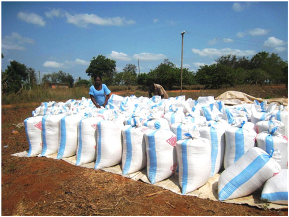
I climbed into the front passenger seat of the 10-ton truck and, after a bumpy 40-minute ride, arrived at Eric’s farm in Afife. This was the field I had visited most often in the past, partly because it was relatively close to Sogakope.
Eric’s face beamed with pride as he greeted us. Behind him were sacks of premium-grade paddy, neatly packed and standing in orderly rows as if quietly awaiting our arrival.
The total harvest from Eric’s 1.6-hectare plot weighed in at 9.3 tons, for a crop yield of 5.8 tons per hectare. The full yield potential for the cultivar of jasmine rice supplied by Copa Connect is approximately 6 tons per hectare; Eric had essentially achieved that in his first growing season. Before enlisting in the Copa Connect pilot, Eric had been growing an inferior variety—the only kind generally available to small farmers in the area—and generally speaking, the yield potential for such rice is substantially higher than for jasmine. Even so, Eric’s farm had been producing only about 3 tons per hectare. To double his yield immediately after switching to jasmine was a stunning achievement.
The grain quality, moreover, was top grade. Fastidious winnowing had removed virtually all foreign matter, including pebbles and dust, and contamination by rice from the previous season amounted to less than 3%. In addition, the moisture content was well within the range considered optimal for milling. This is important because if the paddy is too dry, it results in more breakage during milling. On the other hand, if the paddy contains too much moisture, it has to undergo further drying at the processing plant prior to milling, which adds to costs. Moreover, at large automated facilities, drying is difficult to fine-tune, and the tendency is to over-dry—which, again, leads to more grain breakage and reduces crop value.
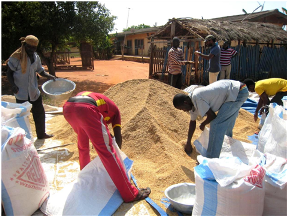
One key to Eric’s success was the fact that he had been able to avoid lodging, the collapse of ripening rice plants under their own weight. This is a perennial problem for rice farmers, affecting both the quantity and quality of harvest. When the rice panicles fall to the ground, they are apt to become soaked and sprout. Harvesting becomes difficult, and the tissue of the grain is often damaged, resulting in a higher percentage of substandard or broken kernels. Rice is particularly prone to lodging when farmers apply the wrong amount of fertilizer or delay the harvest too long. Some smallholder farmers rush the harvest in order to avoid lodging and maximize their yield, but this results in an unacceptably high percentage of immature grains. By following best practices for preventing and coping with such common crop-quality issues, Eric was able to meet the same standard of grain quality as GADCO’s large-scale nucleus farm.
“I’ve never seen anything like it,” marveled Eric, his voice quavering. “I’ve been growing rice for almost twenty years, but this is the first time I’ve ever seen my whole field turn the same beautiful shade of green, and it’s the first time I’ve harvested this many sacks of paddy.”
After all the sacks had been loaded onto the truck, I invited Eric to jump in and accompany us to GADCO’s processing facility. I wanted him to see with his own eyes what was in store for the rice he had grown with such loving care over the previous four months.
On the way, we were stopped repeatedly by police officers demanding payment—bribes, in other words—in exchange for “right of passage.” Moreover, no sooner had we arrived at the GADCO plant than a power outage shut down the entire system. Still, for all its challenges and frustrations, it was a richly rewarding day. As it drew to a close, we all sat in the shade of the GADCO silo and quenched our thirst with some sachet water, * as we conversed with Eric at leisure.
“I owe it all to your help that I’ve done so well with my crop over the past few months,” said Eric. “I’d be lying if I said I never had any worries about enlisting in the pilot. It took some courage to change the way I’ve been farming for so many years—especially with everyone warning me, ‘You’ll be sorry!’ every chance they got.”
Eric turned to face the Copa Connect team’s lead agronomist, who had worked so diligently to support Eric in every aspect of production.
“When you first told me about this program, you said, ‘We’ll give you everything you need in exactly the amount you need, exactly when you need it, so you don’t have to worry about any of that. But in return, you need to follow our advice and work your hardest. If you do that, we can guarantee good results.’ At first I wasn’t sure whether to believe you, because other people have come here making all kinds of promises, and none of them have delivered. But you were different. The very next day after I agreed to participate, you brought me the premium jasmine rice seed you’d promised. That’s when I decided I could trust your word. Later you drove up several times every week to visit and inspect my field. On the days when I was supposed to apply pesticide or fertilizer, you would call and wake me up before dawn, saying you were on your way, and I should be at work by the time you got there. And an hour later, there you would be. You were pretty strict with me at times, but it was all about doing the best job possible in order to grow the finest rice. And thanks to you, I was able to do that.”
Eric’s gaze turned solemn. “I hope with all my heart that everyone else has the same opportunity I’ve had. Whatever your line of work, it takes sweat and tears to do a good job. But if you do your work well, your efforts will be rewarded. That’s the truth, and I want everyone to know it.”
Courage, Conviction, Effort
A few days later, we headed out to Afife again to pay Eric the purchase price for the paddy we had bought, together with a premium reflecting the market value of the polished rice. We explained the pay formula to him in plain language. Next to a slightly tense-looking Eric sat his older brother, absorbing every word.
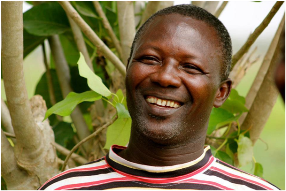
At last, I produced a sheaf of bills and set it in front of Eric, saying, “According to the agreement we reached, this is the payment we owe you for your crop.”
Eric’s face broke into smiles. “For me . . . ? This is so amazing! I’ve never seen so much cash in one place in my life.” Eric continued to grasp the roll of money in both hands, as if feeling its heft over and over.
By dramatically improving his output, both quantitatively and qualitatively, Eric had basically doubled his revenue from the previous harvest. Better yet, his net proceeds after additional expenses (machinery rental and the cost of hiring seasonal workers) were a full four times what he had typically earned.

Eric told us that each harvest usually left him with a little over $400 in ready cash—meaning that his annual net income from rice farming was less than $1,000. This is by no means unusual for smallholders. In fact, many farmers subsist on smaller plots than Eric’s, and their productivity is inevitably lower.
“Until now, I always found myself with so little money left over after expenses that I could barely pay off my debts. We were always living hand to mouth, and we never had enough money for the kids’ education. Now we can finally build a life for ourselves!”
Eric’s gratitude was flattering, but I believe that his success was the reward for his own courage and tireless effort. He was the one who had plunged in, unafraid of change, when everyone else had hung back. Moreover, he had stood by his decision to the end, ignoring the many naysayers around him.
The very low rate of contamination by inferior rice was a testament to Eric’s perseverance. When a rice farmer switches to a new variety, seeds from the old rice will usually keep germinating for another two or three seasons. To produce 100% premium rice fit for Ghana’s end-consumer market, Eric needed to weed out all the unwanted seedlings. We explained GADCO’s quality standards to him at length and warned him that GADCO could not purchase mixed-variety rice from him; any of the old rice plants that sprouted up while he was growing jasmine had to be culled. For a Ghanaian smallholder farmer, accustomed to being rewarded for quantity, not quality, this required a courageous change in mindset. Other farmers in the neighborhood who dropped by out of curiosity would say, “What a waste!” But Eric had the strength of his convictions. He believed he was doing the right thing in order to build a better future for himself and his family. And he was able to make that dream come true.
A SparkTour documentary program about Copa Connect, produced by a French television station.
The Journey Begins
Two weeks later, around the end of March, we were driving around the Volta region trying to get farmers to sign up for Phase 1 of Copa Connect’s commercial launch. Our goal for the first half of 2013 was to enlist 600 smallholders. We were beginning to hold workshops in each district for prospective participants in order to introduce the program, answer questions, and hold small-group discussions regarding the challenges facing local smallholders. At one key meeting, we looked up to see Eric entering the room. He had come, keen to share his experience in his own words.
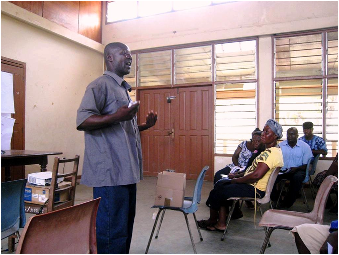
Eyes glowing with energy and self-confidence, Eric stood in front of a few dozen farmers and single-handedly turned the meeting into our liveliest and most productive session yet. The farmers hung on his every word. When he nodded, his audience nodded, too. When he laughed, chuckles rippled through the room. A farmer who had been sitting silently in the back of the room stood and began asking questions. And Eric answered each question with complete sincerity. I had the feeling I was witnessing the birth of a true leader.
This kind of personal transformation, though difficult to quantify, is surely the most important way in which a program like Copa Connect can hope to impact people’s lives. When people like Eric realize their leadership potential, they not only transform their own lives but bring ongoing change to the entire community as role models for the people around them.
As of this writing at the end of August 2013, Copa Connect is partnering with approximately 600 smallholder rice growers. The goal is to bring that number to 1,000 by the end of the year, when Phase 2 begins.
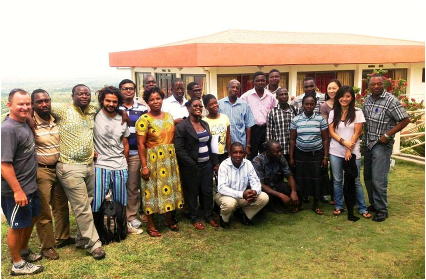
Needless to say, doing business with one farmer (Eric) and doing business with 600 to 1,000 smallholders are two completely different matters. Already the program has encountered a host of difficulties that never emerged during the pilot. Prominent among these are logistics issues. To overcome these, Copa Connect needs to scale its business operations sustainably. It also needs to shift to an innovative business model that leverages community networks.
One of the most pressing challenges Copa Connects faces at the moment is that of securing and training extension officers to provide the kind of individual attention and support Copa Connect smallholders need to meet GADCO’s exacting quality standards. The rapid growth of demand for rice in Ghana is a very recent phenomenon, which is one reason Ghana itself has so few rice specialists compared with India or other Asian countries that have been growing rice as a staple for millennia. A cross-sectoral effort will be needed to bring about a real paradigm shift in Ghana’s rice industry.
We have barely begun to tackle these challenges. This is just the beginning of a long and rocky road. But we are determined to forge ahead. After all, if not us, then who? Since the kickoff of Phase 1, GADCO’s Copa Connect team has expanded, one position at a time, and its dedicated members fill me with hope and confidence.
The Right Stuff
It would be almost impossible to convey all that I learned in the process of launching and developing Copa Connect, an agribusiness designed to integrate impoverished smallholder farmers into the value chain. But one of the most important things I came away with was a first-hand appreciation of what it takes to succeed as a social entrepreneur in a developing country like Ghana.
Good intentions, passion, a carefully crafted business model—all these things are necessary, but they are not sufficient. The most important asset of all is resilience—the ability to recover from setbacks, the flexibility to adapt to change, the toughness to pick yourself up and keep going. Social entrepreneurs need the grit to grapple with the immediate issues confronting them and plow through their daily tasks, even amid a dearth of resources and a corrupt or dysfunctional system. They need the courage to keep trudging forward one step at a time, without letting themselves succumb to the fear of failure or the uncertainties all around them. And above all, they need the conviction to approach their work with a mixture of realism and optimism and an unshakable commitment to their own vision and worldview.
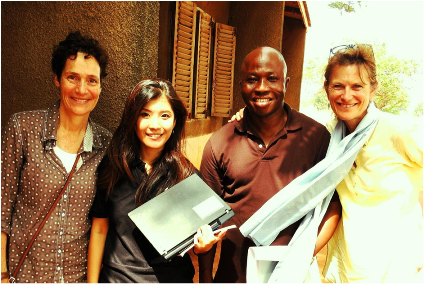
To meet people possessed of these rare qualities in a variety of settings over the course of a year was a truly invaluable experience for me. The nine other 2013 Acumen Global Fellows; the East Africa Fellows with whom I spent time at the Acumen midterm meeting in Kenya; the social entrepreneurs I met through a variety of events; and last but not least, Eric and people like him around the world who grab life by the horns in the tenacious belief that they can alter their future for the better—these are the people who have fueled my hope and kept me going. Thanks to their inspiration, I discovered the confidence and courage to tackle challenges I would once have dismissed as too risky; to celebrate each small step toward the solution of a problem; and to humbly acknowledge and deal with my own weaknesses.
I am grateful above all to the nine other Global Fellows in my cohort. There are so many things I would never have understood, faced, and surmounted had it not been for them. In good times and bad, whenever one of us was bereft, fearful, or confused, we were always there for one another, extending our support across national boundaries and time zones. Although our situations may change, I firmly believe that this fundamental relationship will endure.
*. Filtered water packaged in plastic pouches, or sachets. Although bottled mineral water is safer and better tasting, sachet water is by far more popular in Ghana and is sold virtually everywhere. In terms of unit price, sachet water is actually relatively costly, notwithstanding the low price per pouch.
